
The Laurence M. Gould sailed north yesterday, taking with it 17 friends who have been sharing Palmer Station with us, some since we arrived in February, some for just the past few weeks. That brings the station population down to 27 from its normal maximum level of 44. While the station feels a bit more cozy now, even with 44 it still feels like a home away from home. And just like a family in our northern homes, everyone pitches in to take care of this one.
There is no custodial staff at Palmer. Everyone helps clean up and there are several ways that all Palmerites pitch in every week to take care of the station. The two main ones are called House Mouse and GASH.
I don’t know the derivation of the term House Mouse, but it has been a tradition at Palmer Station since before I first arrived here in late 1985. Every Saturday, everyone gathers in the galley at 2:00 to draw a slip of paper out of a small bucket. On that slip of paper is a cleanup job around station and instructions on what needs to be done for it. That will be your job until you finish it or until the weekly station meeting starts at 3:30.
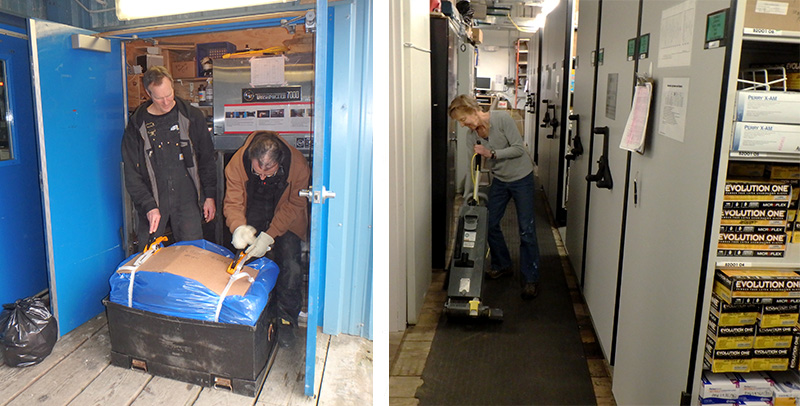
Some of the jobs involve the operational aspects of station. For example above on the right, Maggie is vacuuming the main hallway in the station warehouse. The warehouse has supplies of everything like the rubber lab gloves you can see on the far right to replacement parts for the electric generators that power the station.
One of my favorite jobs is called “Mash & Grind.” It is probably a favorite because it involves two things that one normally wouldn’t do in our northern homes. On the left above you see station waste management specialist Kris Perry and electrician Charles Keating doing the mash part, which is using a compactor that is behind them to compress the week’s soft trash into bales to ship out of Antarctica. What is more fun is the grind part, which is feeding glass bottles into grinder that turns them into small pellets so that they take up less space when being shipped north.
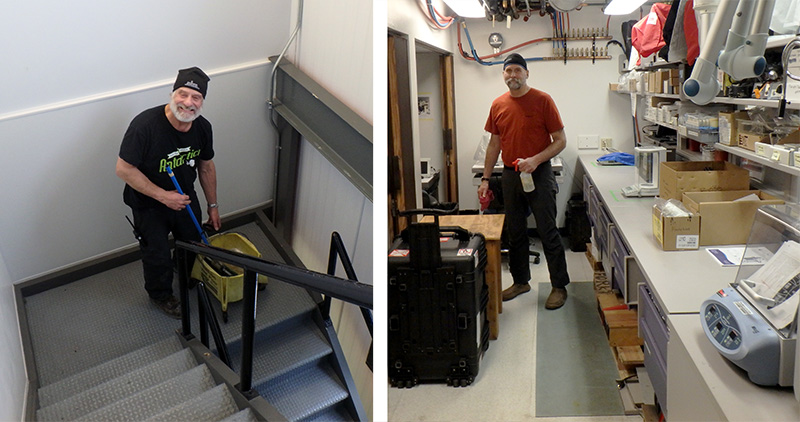
Other jobs include cleaning the corridors that everyone transits through as we move around station. On the left above you see carpenter Rick Osburn mopping the main stairway in the Biolab building.
That stairway leads from the galley down to the labs, and of course the labs need weekly cleaning too. On the right above is satellite communications engineer Mike Rice cleaning one of the shared-use instrument labs.
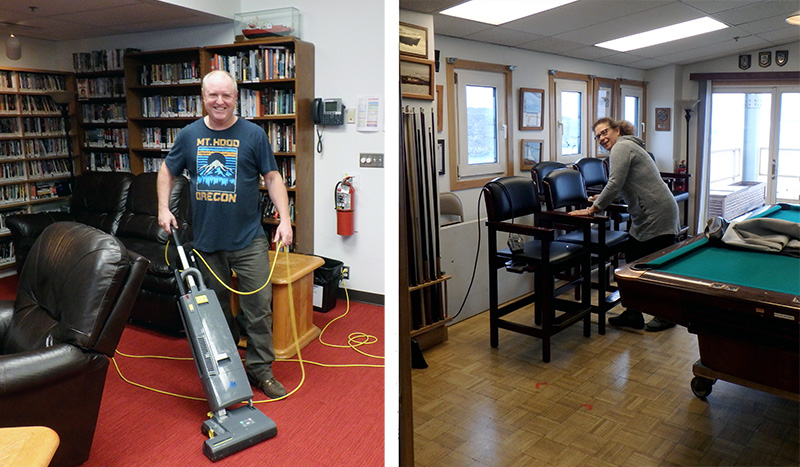
Of course, home is also a place to kick back and play a game or watch a video. Much of that happens in the station lounge which network engineer David Jones and artist Karen Romano Young are shown cleaning.
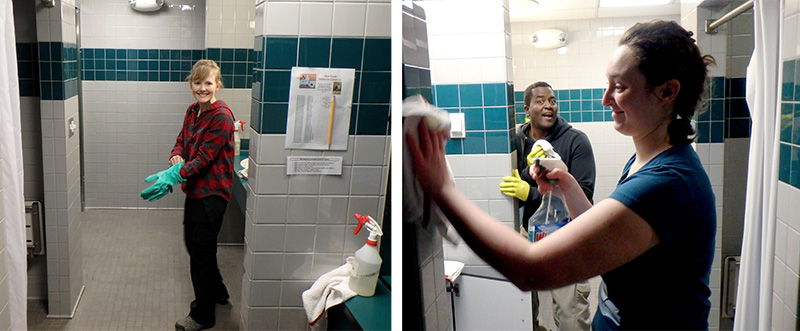
And well, yes, homes have bathrooms too. Ours has seven. The newest are in GWR and you can see CJ on the left above cleaning the men’s GWR bathroom while Sabrina and power plant mechanic Donté Neal are next door cleaning the women’s bathroom. The bathrooms need cleaning more than once a week and so each has a sign-up sheet like you can see on the wall next to CJ. We all sign-up to take turns cleaning the bathrooms again every Wednesday.
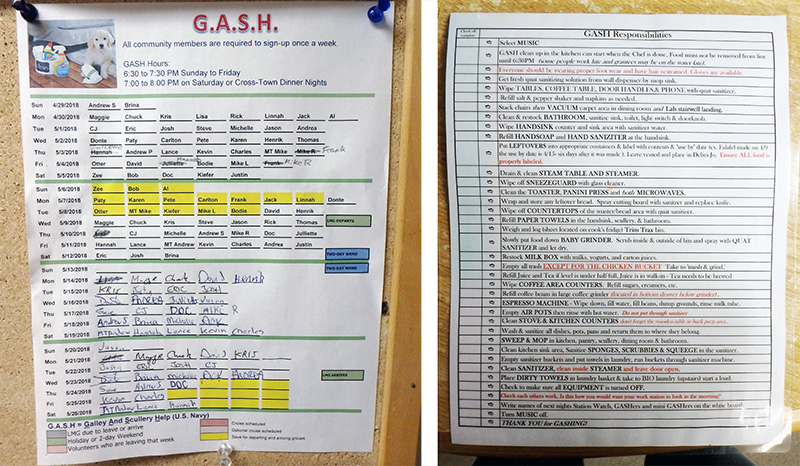
The other cleanup job that everyone does every week is called GASH. In its earliest years, Palmer was administered by the US Navy and the term GASH is a holdover from that meaning “Galley And Scullery Help.” It happens every night, right after the dinner hour.
About once a month, at the end of the Saturday station meeting a new GASH sign-up list goes up on the bulletin board in the galley. Most people line up right away to sign up for their favorite night, often as part of regular “teams” of folks. Others don’t care and so wait to see what slots no one else wants. Regardless, by the time a particular night rolls around, every blank you can see on the signup sheet above will be filled with a name.
GASH teams range from four to as many as seven or eight depending on the station population. There are a lot of jobs involved. As I mentioned, lots of us like to sign up on the same night each week and we typically become a team where everyone knows what job they need to do without looking over the GASH Responsibilities list to figure out what to do next. That makes the teams more efficient, although we always review the list at the end to make sure that everything did indeed get done. GASH usually takes about an hour, but an efficient team can cut that down to 45 minutes or less, particularly if there are more than four of five on the team that night.
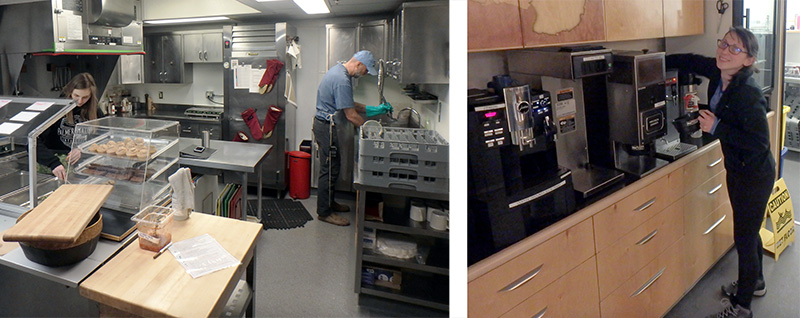
Maggie and I try to be on the same team, and our normal jobs for the start of GASH are Maggie putting away the cooked food and me washing the pots, pans, and other food service items. That’s what you see fish biologist Juliette Auvinet and Mike Rice doing above on the left in an image taken tonight. Michelle’s GASH tasks tonight included cleaning the coffee and tea area.
Although House Mouse, GASH, and other jobs like mid-week bathroom cleanup take a little bit of time away from other things, they add a great deal to the feeling of community, or of family, that we all share at Palmer. Jeff Otten, a network engineer and long-time friend is one of our Palmer family who sailed north yesterday. Jeff created the “HOME” logo that is at the top of this post, basing it on similar designs that are used at other Antarctic research stations. Lots of people here have the logo on stickers on their laptops or water bottles, magnets on metal doors to their offices (likely bound for refrigerators in their northern homes), and on t-shirts. This is a home for us, and you take care of your home. Everyone here shares this home, and we all share in caring for it.